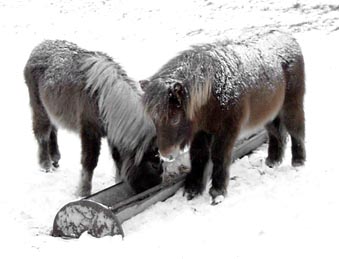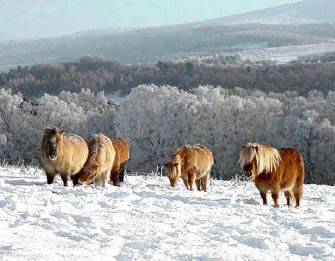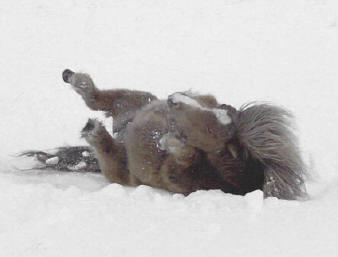|
Breed Characteristics The Shetland Islands are situated at the most northerly tip of the U.K. - far north of the extremities of Scotland. They are open to every gale, buffeted by wild seas, and no more than 3 miles wide, so few trees survive. Some trees have been planted in suitable sheltered spots but are stunted and grow at an acute angle to match the prevailing wind. In spite of these conditions and lack of shelter, the Shetland pony has acclimatised and copes well with any weather and a sparse diet. Shetlands grow a dense double winter coat. The outer layer, consisting of long guard hairs that deflect rain, with a layer of dust and grease close to the skin, helps to insulate the coat. The long mane and forelock protect the head, eyes and neck from rain and snow as well as providing warmth, while a long thick tail guards the soft areas at the hind end. At the top of the tail, a thick, bushy "shute" deflects rain and snow from the naked parts under the tail. So well is the coat insulated, that snow lying on the backs of ponies, does not thaw quickly, proving that little heat is lost from the body. Even the ears, partially covered by the mane, have an impenetrable, thick lining of long, soft hair. Long tactile whiskers on the muzzle act as 'feelers', while the jaw line also has extra long and harsh protective hair. Icicles often hang from the long hair and it is not unusual for a growing snowball to form at the end of the tail as it drags through the snow. Even in deep snow, ponies will dig vigorously with a foreleg to reach any grass hidden below. It can be amusing to watch the ponies playing and chasing each other after snow has fallen. They seem to enjoy it in the same way as children do and usually manage to have a good roll in it.
|
|||
|
|
|
||
|
|
|
|
|
|
Foal winter coats are very thick and when they reach their first
spring, their coats often become very matted with long tufts hanging from
the body. The old Shetland name for a pony in this state was "pellit röll".
|
|||
|
|
|||
| In late spring, the thick winter coat is replaced by a short, fine, silky summer coat. The wealth of mane, forelock and tail help to protect from flies instead of snow. Foals are born with short coats that thicken and grow from birth. Within weeks, the birth coat changes to some extent, first on the muzzle and around the eyes, often giving the foal an appearance of wearing goggles. By autumn, the foal coat has become very long and thick and they are fully prepared for the worst of conditions. | |||
|
|
|||





